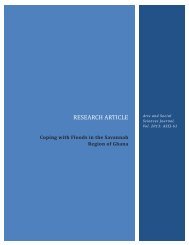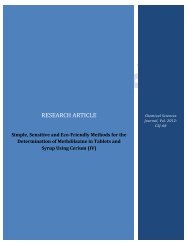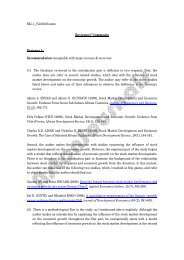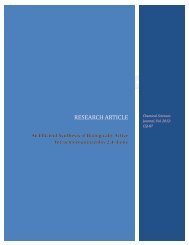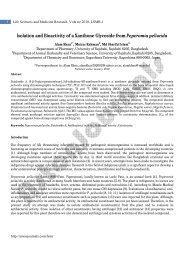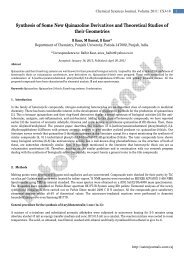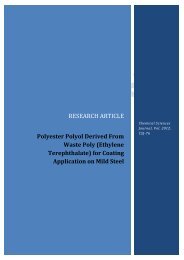Simple and Rapid Spectrophotometric ... - AstonJournals
Simple and Rapid Spectrophotometric ... - AstonJournals
Simple and Rapid Spectrophotometric ... - AstonJournals
Create successful ePaper yourself
Turn your PDF publications into a flip-book with our unique Google optimized e-Paper software.
RESEARCH ARTICLE<br />
<strong>Simple</strong> <strong>and</strong> <strong>Rapid</strong> <strong>Spectrophotometric</strong><br />
Determination of Propranolol<br />
Hydrochloride as Base Form in<br />
Pharmaceutical Formulation through<br />
Charge Transfer Complexation<br />
Chemical Sciences<br />
Journal, Vol. 2012:<br />
CSJ-71
Chemical Sciences Journal, Vol. 2012: CSJ-71<br />
1<br />
<strong>Simple</strong> <strong>and</strong> <strong>Rapid</strong> <strong>Spectrophotometric</strong> Determination of Propranolol<br />
Hydrochloride as Base Form in Pharmaceutical Formulation through<br />
Charge Transfer Complexation<br />
KN Prashanth, K Basavaiah*<br />
Department of Chemistry, University of Mysore, Manasagangotri, Mysore, India.<br />
*Correspondence to: Kanakapura Basavaiah, basavaiahk@yahoo.co.in<br />
Accepted: Sep 14, 2012; Published: Sep 30, 2012<br />
Abstract<br />
Two simple <strong>and</strong> selective spectrophotometric methods are described for the determination of propranolol hydrochloride (PPH)<br />
as base form (PPL) in bulk drug, <strong>and</strong> in tablets <strong>and</strong> capsules. The methods are based on the molecular charge-transfer<br />
complexation of propranolol base (PPL) with either 2,4,6-trinitrophenol (picric acid; PA) or 2,4-dinitrophenol (DNP). The yellow<br />
colored radical anions formed on dissociation, are quantitated at 425 nm (PA method) or 415 nm (DNP method). The assay<br />
conditions were optimized. Beer's law is obeyed in the concentration ranges 2.4-42.0 µg ml -1 in PA method <strong>and</strong> 9.0-126.0 µg ml -<br />
1 in DNP method, with respective molar absorptivity values of 4.97 × 10 3 <strong>and</strong> 1.66 × 10 3 l mol -1 cm -1 . The reaction stoichiometry<br />
in both methods was evaluated by Job’s method of continuous variations <strong>and</strong> was found to be 1:1 (PPL:PA, PPL:DNP). The<br />
developed methods were successfully applied to the determination of PPL in pure form <strong>and</strong> commercial tablets/capsules with<br />
good accuracy <strong>and</strong> precision. Statistical comparison of the results was performed using Student's t-test <strong>and</strong> F-ratio at 95%<br />
confidence level <strong>and</strong> the results showed no significant difference between the reference <strong>and</strong> proposed methods with regard to<br />
accuracy <strong>and</strong> precision. Further, the accuracy <strong>and</strong> reliability of the methods were confirmed by recovery studies via st<strong>and</strong>ard<br />
addition technique.<br />
Keywords: Propranolol hydrochloride; spectrophotometric assay; charge transfer complexes; pharmaceuticals.<br />
1. Introduction<br />
Propranolol hydrochloride (PPH), a non-selective beta-adrenoceptor antagonist, chemically known as (2RS)-1-[(1-<br />
Methylethyl)amino]-3-(naphthalen-1-yloxy)propan-2-ol hydrochloride (Figure 1) [1]. PPH is commonly used in the<br />
management of hypertension, angina pectoris, cardiac dysrhythmias, hypertrophic obstructive cardiomyopathy,<br />
myocardial infarction, anxiety, essential tremor <strong>and</strong> migraine. This beta-blocker may work by stabilizing arteries or<br />
preventing the central generator of migraine in the brainstem from firing. Of the many beta-blockers, PPH is the<br />
most effective for prevention of migraine. The drug is official in British Pharmacopoeia [2] <strong>and</strong> United States<br />
Pharmacopoeia [3], which describe UV-spectrophotometric methods for the assay of PPH after extraction into<br />
methanol, <strong>and</strong> also in Indian Pharmacopoeia [4] which describes a potentiometric titration of drug in ethanol with<br />
0.1 M NaOH.<br />
O<br />
OH<br />
N<br />
H2<br />
.Cl<br />
Figure 1: Structure of propranolol hydrochloride.<br />
Due to its therapeutic <strong>and</strong> pharmacological relevance, several methods have been reported for PPH <strong>and</strong><br />
include high-performance liquid chromatography (HPLC) [4], thin layer chromatography [5], UVspectrophotometry<br />
[6-9], fluorimetry [10], voltammetry [11] <strong>and</strong> chemiluminometry [12, 13]. These techniques<br />
involve an expensive experimental set up <strong>and</strong> are not always easily accessible. Few titrimetric [14, 15] <strong>and</strong> visible<br />
spectrophotometric [16-32] methods have also been reported.<br />
http://astonjournals.com/csj
2 Research Article<br />
Visible spectrophotometry, because of its simplicity <strong>and</strong> cost-effectiveness, sensitivity <strong>and</strong> selectivity <strong>and</strong><br />
fair accuracy <strong>and</strong> precision is routinely used in many industrial quality control laboratories. Several visible<br />
spectrophotometric methods based on different reaction schemes are found in the literature for PPH.<br />
Idowu et al. [16] reported a method for the assay of PPH using diazotized 4-amino-3,5-dinitrobenzoic acid<br />
(ADBA) as the chromogenic derivatizing reagent. Bh<strong>and</strong>ari et al. [17] reported a method based on the reaction of<br />
PPH with 1-chloro-2,4-dinitrobenzene, forming a complex, which absorb maximally at 314.6 nm. In a method<br />
reported by Golcuet al. [18], PPH was reacted with copper (II) or cobalt (II) <strong>and</strong> the colored complexes were<br />
measured at 548 or 614 nm. El-Rieset al. [19] proposed two spectrophotometric methods based on the chargetransfer<br />
complex reaction of PPH with π-acceptors, tetracyanoethylene (TCNE), or chloranilic acid (CLA) to give<br />
highly colored complex species which are quantitated spectrophotometrically at 415 or 510 nm. Salem [20] used<br />
similar reactions for the spectrophotometric determination of PPH which are based on the reaction of PPH as n-<br />
electron donor with the sigma-acceptor iodine <strong>and</strong> π-acceptors such as 7,7,8,8-tetracyaniquinodimethane, 2,3-<br />
dichloro-5,6-dicyano-1,4-benzoquinone, tetracyanoethylene, bromanil <strong>and</strong> chloranil. The resulting CT complexes<br />
were measured at 365, 840, 420, 470, 450 <strong>and</strong> 440 nm, respectively. Hussain et al. [21] reported a method based<br />
on the redox reaction of PPH with cerium (IV) in H 2 SO 4 medium on heating <strong>and</strong> the developed color was measured<br />
at 478 nm. El-Emam et al. [22] reported a method based on oxidative-coupling reaction in which a mixture of an<br />
acidic solution of MBTH <strong>and</strong> PPH was treated with cerium (IV) <strong>and</strong> the resulting orange color peaking at 496 nm<br />
was measured.<br />
In addition to direct methods described above, several indirect methods based on a variety of reaction<br />
chemistries are also found in the literature. A spectrophotometric method proposed by Basavaiah et al. [23] makes<br />
use of the reaction between chloride of PPH <strong>and</strong> mercury(II) thiocyanate in which thiocyanate ions displaced<br />
complexed with iron(III) for subsequent measurement at 460 nm. In a spectrophotometric method reported by<br />
Basavaiah et al. [24], the unreacted cerium(IV) sulphate was treated with iron(II) <strong>and</strong> the iron(III) was complexed<br />
with thiocyanate <strong>and</strong> measured at 480 nm. Similar method reported by Basavaiah et al. [25] is based on the<br />
oxidation of PPH by a known excess of CAT in acid medium followed by determination of the unreacted oxidant by<br />
reacting with metal <strong>and</strong> sulphanilic acid. The same authors reported another spectrophotometric method in which<br />
the unreacted oxidant metavanadate was determined by reacting with diphenylamine, <strong>and</strong> the absorbance<br />
measured at 560 nm [26]. A method reported by Basavaiah et al. [27] involves the addition of a known excess of<br />
bromate-bromide mixture to an acidified solution of the drug <strong>and</strong> determination of the unreacted bromine by its<br />
bleaching action on methyl orange acid color <strong>and</strong> the absorbance measured at 510 nm. El-Didamony [28] reported<br />
three methods based on oxidation-bromination reaction of PPH by bromine, generated in situ by the action of acid<br />
on a bromate-bromide mixture, followed by determination of unreacted bromine by three different reaction<br />
schemes. In one method the residual bromine was determined by indigo carmine dye. In the other two methods,<br />
the residual bromine was determined by treating with a known excess of iron(II) <strong>and</strong> the resulting iron(III) was<br />
complexed with thiocyanate or the residual iron(II) with 1,10-phenanthroline. Gowda et al. [29] reported two<br />
procedures, similar to the above, in which PPH was oxidized by a known excess of NBS in H 2 SO 4 medium followed<br />
by the reaction of unreacted oxidant with promethazine hydrochloride (PH) or methdilazine hydrochloride (MDH)<br />
to yield red colored products with absorption maximum at 515 or 513 nm. Two methods described by Al-Attas et<br />
al. [30] based on the oxidation of PPH by a known excess of N-bromosuccinimide (NBS), in an acidic medium<br />
followed by the reaction of excess oxidant with amaranth dye. Sastry et al. [31] devised one more method by<br />
treating PPH with a known excess of NBS in HCl medium, <strong>and</strong> after 10 min, the unreacted oxidant was determined<br />
by reacting with celestine blue <strong>and</strong> measuring the absorbance at 540 nm.<br />
Most of the reported spectrophotometric methods suffer from one or the other disadvantage such as use<br />
of heating/extraction step, critical dependence on pH, narrow linear range, poor sensitivity, use of multi reagents/<br />
multi step reactions, longer contact time etc. as summarized in Table 1. The methods based on C-T complexation<br />
reactions <strong>and</strong> using σ <strong>and</strong> π acceptors [19, 20] are less sensitive <strong>and</strong> have narrow linear ranges. Though substituted<br />
phenols (picric acid <strong>and</strong> dinitrophenol) have found wide applications as C-T complexing agents in the assay of<br />
pharmaceuticals [32-34], they have not applied for the assay of PPH. In this work, we demonstrate the use of picric<br />
acid <strong>and</strong> dinitrophenol as C-T complexing agents for the simple, rapid, sensitive <strong>and</strong> selective assay of PPH in<br />
pharmaceuticals. The methods are based on the formation of C-T complex of PPH base (PPL) with picric acid<br />
(method A) or dinitrophenol (method B) followed by the measurement of the absorbance of the colored species at<br />
420 nm. The methods were demonstrated to be accurate, precise, robust <strong>and</strong> rugged, <strong>and</strong> eminently suited for<br />
rapid analysis in routine work.<br />
http://astonjournals.com/csj
Chemical Sciences Journal, Vol. 2012: CSJ-71<br />
3<br />
Reagent/s<br />
Table 1: Comparison of the proposed <strong>and</strong> the existing visible spectrophotometric methods.<br />
λ max<br />
nm<br />
Beer’s law<br />
range, µg ml -1<br />
(ε in l mol -1 cm -1 )<br />
Remarks<br />
4-amino-3,5- 470 1.0-8.0 Heating required 16<br />
dinitrobenzoic acid<br />
1-chloro-2,4- 314.6 - - 17<br />
dinitrobenzene<br />
Copper(II) or Cobalt(II) 548/614 2x10 -5 -1×10 -2 M - 18<br />
Tetracyanoethylene, 415<br />
- Use of large quantity of organic solvents 19<br />
chloranilic acid 510<br />
σ <strong>and</strong> π-acceptors - 4-120 Use large quantity of organic solvents; 20<br />
less sensitive<br />
Cerium(IV) 478 15-350 Involves boiling for 25 min; less sensitive 21<br />
Cerium(IV)-MBTH 496 1-10 Uses an expensive chemical 22<br />
Mercury(II) thiocyanateiron(III)<br />
460 10-50<br />
- 23<br />
(2.63×10 3 )<br />
Cerium (IV)-iron (II) 480 0.0-5.0<br />
Multi-step reaction 24<br />
sulphate-thiacyanate.<br />
(3.6×10 4 )<br />
Chloramine-T-metol <strong>and</strong> 520 0.0-3.0 Less sensitive, multi-step reaction,<br />
25<br />
sulphanilic acid.<br />
(7.1×10 3 )<br />
critical pH<br />
Sodium metavanadatediphenylamine.<br />
560 0.0-4.0<br />
Multi-step reaction 26<br />
(5.33×10 4 )<br />
Bromate-bromidemethyl<br />
510 0.5-3.5<br />
Multi-step reaction 27<br />
orange<br />
(6.66×10 4 )<br />
Bromate-bromide<br />
a)Indigo carmine<br />
b)Fe(III)+thiocyanate<br />
c)Fe(III)+1,10-<br />
phenanthroline<br />
610<br />
480<br />
510<br />
1.0-13.0<br />
4.0-12.0<br />
2.0-9.0<br />
Multi-step reaction 28<br />
a)NBS-PH<br />
515 0.5-12.5<br />
Multi-step reaction 29<br />
b)NBS-MDH<br />
513<br />
(1.36x10 4 )<br />
0.3-16.0<br />
(2.55x10 4 )<br />
a)N-bromosuccinimide-<br />
0.2-6.4 Multi-step reaction 30<br />
amaranth<br />
NBS-Celestine blue 540 0.4-3.0 Multi-step reaction 31<br />
a) PA<br />
b) DNP<br />
415<br />
425<br />
2.4-42.0<br />
(4.97×10 3 )<br />
9.0-126.0<br />
(1.66×10 3 )<br />
<strong>Simple</strong>, rapid, sensitive, selective <strong>and</strong><br />
use a single reagent. Single step reaction<br />
<strong>and</strong> no heating/extraction step involved.<br />
Ref.<br />
Proposed<br />
methods<br />
2. Methods<br />
2.1 Instrument<br />
A Systronics model 106 digital spectrophotometer (Systronics, Ahmedabad, Gujarat, India) provided with 1 cm<br />
matched quartz cells was used for all absorbance measurements.<br />
http://astonjournals.com/csj
4 Research Article<br />
2.2 Materials<br />
Pharmaceutical grade PPH certified to be 99.80% pure was received from Cipla India Ltd., Mumbai, India. The<br />
following pharmaceutical preparations were purchased from commercial sources in the local market <strong>and</strong> subjected<br />
to analysis: Monoprolol-20 (20 mg PPH per tablet) from Cosmo Life Sciences Ltd., India; Ciplar – 40(40 mg PPH per<br />
tablet) from Cipla India Ltd., India <strong>and</strong> Betacap-40 (40 mg PPH per capsule) from Sun Pharma Ltd., India.<br />
2.3 Reagents <strong>and</strong> chemicals<br />
All reagents used were of analytical reagent grade <strong>and</strong> HPLC grade organic solvents were used throughout the<br />
investigation. Solutions of 0.1% each of picric acid (S.D. Fine Chem., Mumbai, India) <strong>and</strong> dinitrophenol (S.D. Fine<br />
Chem., Mumbai, India) in dichloromethane were prepared separately. A stock st<strong>and</strong>ard solution containing 180 µg<br />
ml -1 PPL was prepared as follows: pure propranolol hydrochloride (20.5 mg) dissolved in 20 ml water in a 125 ml<br />
separating funnel, 5 ml of liquid ammonia was added followed by 20 ml of dichloromethane. The content was<br />
shaken for 15 minutes. The lower organic layer was collected in a beaker containing anhydrous sodium sulphate.<br />
The water-free organic layer was transferred into a 100 ml calibrated flask <strong>and</strong> diluted to the volume with the<br />
same solvent to get 180 µg ml -1 with respect to PPL (hydrochloride free propranolol). This solution was used as such<br />
in method B <strong>and</strong> diluted appropriately with dichloromethane to get working concentrations of 60 µg ml -1 for use in<br />
method A.<br />
Recommended procedures<br />
2.3.1 Method A (using picric acid, PA)<br />
Different aliquots (0.2–3.5ml) of a st<strong>and</strong>ard PPL solution (60 µg ml -1 ) were transferred into a series of 5 ml<br />
calibrated flasks using a micro burette <strong>and</strong> the total volume was adjusted to 3.5 ml with dichloromethane. To each<br />
flask was added 1 ml of 0.1 % PA solution <strong>and</strong> after 5 min made up to mark with the same solvent. The absorbance<br />
of the resulting yellow colored chromogen was measured against the reagent blank at 420 nm.<br />
2.3.2 Method B (using dinitrophenol, DNP)<br />
Into a series of 5 ml calibrated flasks, 0.2–3.5 ml of 180 µg ml -1 of st<strong>and</strong>ard PPL solution were added using a micro<br />
burette <strong>and</strong> the total volume was made up to 3.5ml with dichloromethane. To each flask was added 1 ml of 0.1 %<br />
DNP solution <strong>and</strong> the volumes were made up to the mark with the same solvent after 5 min. The absorbance of<br />
the resulting yellow colored product was measured against the reagent blank at 420 nm. In either case, the<br />
calibration graph was obtained for the absorbance vs concentration of PPL <strong>and</strong> the concentration of the unknown<br />
was read from the calibration or computed from the regression equation.<br />
2.3.3 Procedure for formulations<br />
Ten tablets or content of ten capsules were weighed accurately <strong>and</strong> ground into a fine powder. A portion of the<br />
powder equivalent to 20.5 mg of PPH was accurately weighed <strong>and</strong> transferred into 125 ml separating funnel. The<br />
procedure of conversion of PPH to PPL base was followed as done for pure PPH. The resulting solution of 180 µg<br />
ml -1 PPL was used as such (method B) or diluted to get working concentration 60 µg ml -1 PPL (method A), <strong>and</strong><br />
suitable aliquots were analyzed following the procedures described above.<br />
2.3.4 Procedure for the analysis of placebo blank <strong>and</strong> synthetic mixture<br />
A placebo blank of the composition: talc (100 mg), starch (50 mg), acacia (50 mg), methyl cellulose (100 mg),<br />
sodium citrate (50 mg), magnesium stearate (100 mg), <strong>and</strong> sodium alginate (50 mg) was prepared <strong>and</strong> 40 mg was<br />
extracted with dichloromethane <strong>and</strong> solution was made as described under preparation of st<strong>and</strong>ard drug. A<br />
convenient aliquot of solution was subjected to analysis by both the methods following the recommended<br />
procedures.<br />
To the 20 mg of the placebo blank described above, 20.5 mg of PPH was added <strong>and</strong> homogenized. The<br />
solution of the synthetic mixture equivalent to 180 μg ml - 1 of PPL was prepared as described under procedure for<br />
formulations. The resulting solution was assayed (n = 5) by the proposed methods after appropriate dilution in<br />
method A.<br />
http://astonjournals.com/csj
Absorbance<br />
Absorbance<br />
Chemical Sciences Journal, Vol. 2012: CSJ-71<br />
5<br />
3. Results <strong>and</strong> Discussion<br />
3.1 Absorption spectra<br />
The reaction of PPL as n-electron donor <strong>and</strong> PA <strong>and</strong> DNP as π-acceptors results in the formation of C-T complexes.<br />
The absorption spectra of PPL-PA <strong>and</strong> PPL-DNP charge-transfer complexes resulted in the formation of an intense<br />
yellow color which exhibited absorption maximum at 420 nm in both the cases (Figure 2).<br />
0.7<br />
0.6<br />
0.5<br />
blank<br />
PA: PPL C-T Complex<br />
0.4<br />
0.3<br />
0.2<br />
0.1<br />
0.0<br />
380 400 420 440 460 480 500<br />
Wavelength, nm<br />
(a)<br />
0.5<br />
0.4<br />
PPL:DNP C-T complex<br />
Blank<br />
0.3<br />
0.2<br />
0.1<br />
0.0<br />
340 360 380 400 420 440 460 480 500 520<br />
Wavelength, nm<br />
(b)<br />
Figure 2: Absorption spectra of (a) PPL-PA charge-transfer complex <strong>and</strong> (b) PPL-DNP charge-transfer complex.<br />
http://astonjournals.com/csj
6 Research Article<br />
3.2 Reaction mechanism<br />
In general, the intensely colored product formed between aromatic-NO 2 compounds <strong>and</strong> amine type Lewis bases<br />
may be attributed to the partial transfer of electronic charge (i.e., through overlap of orbitals of appropriate<br />
symmetry) from the Lewis base to the aromatic nucleus of the nitro-compound depleted off electron density,<br />
owing to the electron-attracting behaviour of the–NO 2 substituents. This phenomenon was named as chargetransfer<br />
interaction after Mulliken [34, 35]. Interaction between nitrophenols (PA, DNP) <strong>and</strong> amine of PPL may give<br />
rise to the formation of a Lewis salt where a proton is transferred from nitrophenols to the amine, as well as to<br />
charge-transfer interaction via partial transfer of charge from n-lone pair of the amine to the oxygen-π* of the<br />
nitro-group [36]. Modern underst<strong>and</strong>ing of CT interaction involves the partial transfer of charge from the Highest<br />
Occupied Molecular Orbital (HOMO) to the Lowest Unoccupied Molecular Orbital (LUMO) of the CT complex [37].<br />
Specifically, the nature of interaction between PA or DNP <strong>and</strong> PPL is presumed to be of charge-transfer type (i.e.,<br />
transfer of electronic charge from the amine donor to nitrophenol acceptors) as shown in Scheme.<br />
O<br />
OH<br />
N<br />
H2<br />
.Cl<br />
OH<br />
R 3 R 1<br />
O<br />
OH<br />
N<br />
H2<br />
.Cl<br />
R 3 OH<br />
R 1<br />
R 2<br />
Propranolol hydrochloride (PPH)<br />
PA orDNP<br />
R 2<br />
O<br />
OH<br />
N<br />
H2<br />
.Cl<br />
C-T complexation<br />
O<br />
R 3 R 1<br />
R 2<br />
C-T complex<br />
the measured species<br />
For PA: R 1 =R 2 =R 3 =NO 2 <strong>and</strong><br />
For DNP: R 1 =R 2 =NO 2 <strong>and</strong> R 3 =H<br />
Scheme: Proposed reaction pathway.<br />
3.3 Optimization of experimental variables<br />
Experimental variables which were found to affect the color intensity <strong>and</strong> stability of the resulting complexes were<br />
optimized to achieve maximum sensitivity <strong>and</strong> adherence to Beer’s law.<br />
3.3.1 Effect of reagent concentration<br />
The optimum concentration of the reagent required to achieve maximum sensitivity of the colored species in each<br />
method was ascertained by adding different amounts of the reagent PA or DNP to a fixed concentration of PPL.<br />
The results showed that 1.0 ml of 0.1% PA or 0.1% DNP solution was optimum for the production of maximum <strong>and</strong><br />
reproducible color intensity (Figure 3).<br />
3.3.2 Effect of solvent<br />
In order to select a suitable solvent for preparation of the reagent solutions used in the study, the reagents were<br />
prepared separately in different solvents such as 1,4-dioxane, chloroform, acetonitrile, acetone, t-butanol, 2-<br />
propanol <strong>and</strong> dichloromethane, <strong>and</strong> the reaction of PPL with PA or DNP was followed. The dichloromethane<br />
solvent was found to be the ideal solvent for preparation of both PA <strong>and</strong> DNP for method A <strong>and</strong> method B,<br />
respectively (Figure 4). Similarly, the effect of the diluting solvent was studied for both methods <strong>and</strong> the results<br />
showed that the ideal diluting solvent to achieve maximum sensitivity was dichloromethane in both the methods.<br />
http://astonjournals.com/csj
1,4-Dioxan<br />
Chloroform<br />
Acetonitrile<br />
Acetone<br />
t-Butanol<br />
2-Propanol<br />
Dichloromethane<br />
Absorbance<br />
Absorbance<br />
Chemical Sciences Journal, Vol. 2012: CSJ-71<br />
7<br />
0.6<br />
0.5<br />
0.4<br />
0.3<br />
PPL-PA C-T complex<br />
PA-blank<br />
PPL-DNP C-T complex<br />
DNP-blank<br />
0.2<br />
0.1<br />
0.0<br />
0.5 1.0 1.5 2.0 2.5 3.0<br />
Volume of reagent, ml<br />
Figure 3: Effect of reagent (30 µg ml -1 PPL in method A <strong>and</strong> 80 µg ml -1 PPL in method B).<br />
0.45<br />
0.40<br />
0.35<br />
0.30<br />
0.25<br />
0.20<br />
PA-blank<br />
PPL-PA C-T complex<br />
DNP-blank<br />
PPL-DNP C-T complex<br />
0.15<br />
0.10<br />
0.05<br />
Solvents<br />
Figure 4: Effect of solvents (24 µg ml -1 PPL in method A <strong>and</strong> 72 µg ml -1 PPL in method B).<br />
http://astonjournals.com/csj
Absorbance<br />
Absorbance<br />
8 Research Article<br />
3.3.3 Effect of reaction time <strong>and</strong> stability of the C-T complexes<br />
The optimum reaction times were determined by measuring the absorbance of the complex formed upon the<br />
addition of reagent solution to PPL solution at room temperature. The reaction of PPL with PA in method A <strong>and</strong><br />
DNP in method B takes 5 min for complete color development. The absorbance of the resulting C-T complexes<br />
remained stable for at least 2 hrs in method A <strong>and</strong> for about 3 hrs in method B.<br />
3.3.4 Reaction stoichiometry<br />
Job's method of continuous variations of equimolar solutions was employed to establish the stoichiometry of the<br />
PA method <strong>and</strong> DNP method. The solutions of PPL <strong>and</strong> PA equivalent to 2.31×10 –4 M in method A <strong>and</strong> the solutions<br />
of PPL <strong>and</strong> DNP equivalent to 5.78×10 –4 M were prepared in dichloromethane. The solutions were mixed in various<br />
proportions; the volume was completed to the mark with same solvent <strong>and</strong> the absorbance of each solution was<br />
measured at the λ max . The resulting graph (Figure 5) shows that the interaction occurs on an equimolar basis (1:1<br />
reaction stoichiometry), owing to the presence of one basic nitrogen containing group.<br />
0.6<br />
0.5<br />
0.4<br />
0.30<br />
0.25<br />
0.20<br />
0.3<br />
0.15<br />
0.2<br />
0.10<br />
0.1<br />
0.05<br />
0.0<br />
0.0 0.2 0.4 0.6 0.8 1.0<br />
Mole ratio, (V PPL<br />
/V ppl<br />
+V PA<br />
)<br />
0.00<br />
0.0 0.2 0.4 0.6 0.8 1.0<br />
Mole ratio, (V PPL<br />
/V PPL<br />
+V DNP<br />
)<br />
(a)<br />
(b)<br />
Figure 5: Job’s continuous variation plot: (a) [PPL] <strong>and</strong> [PA] = 2.31 ×10 -4 M; (b) [PPL] <strong>and</strong> [DNP] = 5.78×10 -4 M.<br />
3.4 Method validation<br />
3.4.1 Analytical data<br />
The linear regression equations were obtained by the method of least squares <strong>and</strong> the Beer's law range, molar<br />
absorptivity, correlation coefficient, variance, confidence limits for slope <strong>and</strong> intercept for both methods are<br />
summarized in Table 2. The detection limit (LOD) <strong>and</strong> quantification limit (LOQ) were calculated by using the<br />
following equations [38]:<br />
3 &<br />
LOD<br />
. 3<br />
S<br />
10 <br />
LOQ <br />
S<br />
where, σ is the st<strong>and</strong>ard deviation of seven replicate determinations under the same conditions as for the sample<br />
in the absence of the analyte <strong>and</strong> S is the slope of the calibration graph.<br />
3.4.2 Accuracy <strong>and</strong> precision<br />
In order to determine the accuracy <strong>and</strong> precision of the proposed methods, pure drug (PPL) solution at three<br />
different concentration levels (within the working range) were prepared <strong>and</strong> analyzed in seven replicates during<br />
the same day (intra-day precision) <strong>and</strong> on five consecutive days (inter-day precision) <strong>and</strong> the results are presented<br />
in Table 3. The percentage relative error (RE%) was ≤ 1.53 which indicates that the accuracy of the methods is<br />
satisfactory. Percentage relative st<strong>and</strong>ard deviation (RSD%) for intra-day was ≤ 0.93 <strong>and</strong> for inter-day it was ≤ 1.25<br />
indicating repeatability <strong>and</strong> usefulness of the proposed methods in the routine analysis.<br />
http://astonjournals.com/csj
Chemical Sciences Journal, Vol. 2012: CSJ-71<br />
9<br />
Table 2: Regression <strong>and</strong> analytical parameters.<br />
Parameter PA Method DNP Method<br />
max , nm 415 425<br />
Beer’s law limits (µg ml -1 ) 2.4-42.0 9.0-126.0<br />
Molar absorptivity (l mol -1 cm -1 ) 4.97×10 3 1.66×10 3<br />
S<strong>and</strong>ell sensitivity* (µg cm -2 ) 0.0522 0.1565<br />
Limit of detection (µg ml -1 ) 0.46 0.63<br />
Limit of quantification (µg ml -1 ) 1.38 1.92<br />
Regression equation, Y** Intercept, (a) -0.0026 0.0101<br />
Slope, (b) 0.0197 0.0059<br />
Correlation coefficient (r) 0.9998 0.9996<br />
St<strong>and</strong>ard deviation of intercept (S a ) 0.00544 0.00669<br />
St<strong>and</strong>ard deviation of slope (S b ) 0.00022 0.00008<br />
*Limit of determination as the weight in µg per ml of solution, which corresponds to an absorbance of A = 0.001 measured in a<br />
cuvette of cross-sectional area 1 cm 2 <strong>and</strong> l = 1 cm. ** Y a bX<br />
, where Y is the absorbance, a is the intercept, b is the slope<br />
<strong>and</strong> X is the concentration in µg ml -1 .<br />
Table 3: Evaluation of intra-day <strong>and</strong> inter-day precision <strong>and</strong> accuracy.<br />
Intra-day (n = 7) Inter-day (n = 5)<br />
Method PPL taken PPL found a %RSD b %RE c PPL found a %RSD b %RE c<br />
(µg ml -1 ) (µg ml -1 )<br />
(µg ml -1 )<br />
12.00 12.15 0.73 1.26 12.18 1.23 1.50<br />
PA Method 24.00 23.87 0.57 0.56 24.20 1.25 0.83<br />
36.00 36.43 0.74 1.20 36.70 1.14 1.94<br />
36.00 36.34 0.93 0.94 36.50 1.02 1.39<br />
DNP Method 72.00 73.06 0.77 1.48 73.10 0.77 1.53<br />
108.00 109.21 0.84 1.12 109.5 0.85 1.39<br />
a Mean value of five determinations; b Relative st<strong>and</strong>ard deviation (%); c Relative error (%).<br />
3.4.3 Selectivity<br />
Upon analysis of placebo blank solution as described under “Procedure for formulations”, the resulting absorbance<br />
readings for both the methods were same as reagent blank, inferring no interference from the placebo. Noninterference<br />
from placebo was further confirmed by carrying out recovery study from synthetic mixture prepared<br />
by adding 20.5 mg of PPH to 100 mg of the placebo blank. The percent recoveries of PPL were 100.93 ± 0.63 <strong>and</strong><br />
102.56 ± 0.76 for PA method <strong>and</strong> DNP method, respectively. This confirms the selectivity of methods in the<br />
presence of the commonly employed tablet excipients.<br />
3.4.4 Robustness <strong>and</strong> ruggedness<br />
To evaluate the robustness of the methods, two important experimental variables volume of reagent <strong>and</strong> reaction<br />
time, were slightly altered <strong>and</strong> the effect of this change on the absorbance of the C-T complexes was studied. The<br />
results of this study are presented in Table 4 <strong>and</strong> indicated that the proposed methods are robust. Method<br />
ruggedness was evaluated by performing the analysis following the recommended procedures by three different<br />
analysts <strong>and</strong> on three different spectrophotometers by the same analyst. From the %RSD values presented in Table<br />
4, one can conclude that the proposed methods are rugged.<br />
http://astonjournals.com/csj
10 Research Article<br />
Method<br />
PA Method<br />
Table 4: Robustness <strong>and</strong> ruggedness.<br />
µg ml Reagent volume, ml a Reaction time b Inter-analysts Inter-<br />
Method robustness Method ruggedness<br />
PPL taken,<br />
Parameters altered<br />
RSD, %<br />
(n = 3)<br />
RSD, %<br />
(n = 3)<br />
RSD, %<br />
(n = 4)<br />
cuvettes<br />
RSD, %<br />
(n = 4)<br />
12.00 0.96 1.18 1.24 1.50<br />
24.00 1.06 0.92 1.40 1.32<br />
36.00 0.81 1.29 1.17 1.09<br />
DNP Method 36.00 1.22 0.79 1.56 1.27<br />
72.00 1.18 1.27 1.33 1.43<br />
108.00 1.35 1.48 1.57 1.01<br />
a<br />
In both methods, the volume of reagent was 0.8, 1.0 <strong>and</strong> 1.2 mL. b The reaction time was 4, 5 <strong>and</strong> 6 min.<br />
3.4.5 Application to analysis of formulations<br />
The proposed methods were applied to the determination of PPH in tablets <strong>and</strong> capsules (Table 5). The results<br />
obtained were statistically compared with those of the official method [4] by applying the Students t-test for<br />
accuracy <strong>and</strong> F-test for precision. The official method describes a potentiometric titration of ethanolic solution of<br />
PPH with sodium hydroxide. As can be seen from the Table 5, the calculated t <strong>and</strong> F-value at 95 % confidence level<br />
did not exceed the tabulated values of 2.78 <strong>and</strong> 6.39, respectively, for four degrees of freedom. The results<br />
indicated that there is no difference between the proposed methods <strong>and</strong> the official method with respect to<br />
accuracy <strong>and</strong> precision.<br />
Tablet br<strong>and</strong> name<br />
a<br />
Mean value of five determinations.<br />
Tabulated t-value at the 95% confidence level is 2.78.<br />
Tabulated F-value at the 95% confidence level is 6.39.<br />
Table 5: Results of analysis of tablets by the proposed methods.<br />
Label claim<br />
mg/tablet<br />
Found (Percent of label claim ±SD) a<br />
Reference method<br />
Proposed methods<br />
PA Method<br />
DNP Method<br />
101.00 ± 1.03<br />
t = 1.03<br />
F = 2.59<br />
Monoprolol-20 20 101.56 ± 0.64 102.11 ± 0.98<br />
t = 1.05<br />
F = 2.34<br />
Ciplar-40 40 100.56 ± 0.75 101.63 ± 1.25<br />
t = 1.64<br />
F = 2.78<br />
Betacap-40 40 100.19 ± 1.06 100.99 ± 1.59<br />
t = 0.94<br />
F = 2.25<br />
101.28 ± 1.08<br />
t = 1.22<br />
F = 2.07<br />
99.07 ± 1.30<br />
t = 1.49<br />
F = 1.50<br />
3.4.6 Recovery studies<br />
Accuracy of the proposed methods was further confirmed by st<strong>and</strong>ard-addition procedure. Pre-analyzed tablet<br />
powder (Monoprolol-20; Ciplar–40) or the content of capsule (Betacap-40) was spiked with pure PPL at three<br />
different concentration levels (50, 100, <strong>and</strong> 150 % of the quantity present in the formulation) <strong>and</strong> the total was<br />
found by the proposed methods. The result of the recovery study is shown in Table 6.<br />
http://astonjournals.com/csj
Chemical Sciences Journal, Vol. 2012: CSJ-71<br />
11<br />
Tablets<br />
studied<br />
Monoprolol-20<br />
Ciplar-40 12.20<br />
12.20<br />
12.20<br />
Table 6: Results of recovery study by st<strong>and</strong>ard addition method.<br />
4. Conclusion<br />
Formation of n-π charge-transfer complex between n-electron donor PPL <strong>and</strong> π-acceptor PA or DNP was used to<br />
develop two rapid, accurate <strong>and</strong> precise methods for propranolol hydrochloride (PPH) in its dosage forms. Possibly,<br />
these are the simplest methods ever for PPH since they involve simple mixing of the drug <strong>and</strong> reagent solutions in<br />
dichloromethane <strong>and</strong> absorbance measurement. Both methods are absolutely free from any critical experimental<br />
variables unlike in most reported methods (Table 1). This is reflected in high accuracy <strong>and</strong> precision of results<br />
(intra-day %RE <strong>and</strong> %RSD being
12 Research Article<br />
12. Marques KL, Santos JLM, Lima JLFC, 2005. Chemiluminometric determination of propranolol in an automated<br />
multicommutated flow system. Journal of Pharmaceutical <strong>and</strong> Biomedical Analysis, 39: 886–891.<br />
13. Qi H, Wang C, Zou R, et al., 2011. Electrogenerated chemiluminescence sensor for the determination of propranolol<br />
hydrochloride. Analytical Methods, 3: 446-451.<br />
14. Issa YM, Amin AS, 1995. Conductometric titration of pindolol <strong>and</strong> propranolol using ammonium reineckate <strong>and</strong> potassium<br />
tetracyanonickelate. Microchimica Acta, 116: 85-91.<br />
15. Idowu OS, Adegoke OA, Olaniyi AA, 2004. Colorimetric assay of propranolol tablets by derivatization: Novel application of<br />
diazotized 4-amino-3,5-dinitrobenzoic acid (ADBA). Journal of AOAC International, 87: 573-578.<br />
16. Bh<strong>and</strong>ari A, Kumar B, Patel R, 2008. <strong>Spectrophotometric</strong> estimation of propranolol in tablet dosage form. Asian Journal of<br />
Chemistry, 20: 802-804.<br />
17. Golcu A, Yucesoy C, Sesin S, 2004. <strong>Spectrophotometric</strong> determination of some beta-blockers in dosage forms based on<br />
complex formation with Cu(II) <strong>and</strong> Co(II). IL Farmaco, 59: 487-492.<br />
18. El-Ries MA, Abou-Attia FM, Ibrahim SA, 2000. AAS <strong>and</strong> spectrophotometric determination of propranolol HCl <strong>and</strong><br />
metoprolol tartrate. Journal of Pharmaceutical <strong>and</strong> Biomedical Analysis, 24: 179-187.<br />
19. Salem H, 2001. <strong>Spectrophotometric</strong> study of the charge transfer complexes of some beta-adrenergic blocking drugs. Journal<br />
of Pharmaceutical Sciences, 28: 319-337.<br />
20. Hussain S, Krishnamurthy ASR, Sekar R, et al., 1995. Ceric(VI) oxidation studies of propranolol <strong>and</strong> its application to<br />
pharmaceutical preparations. Indian Drugs, 32: 574-577.<br />
21. El-Emam AA, Belal FF, Montsufa MA, et al., 2003. <strong>Spectrophotometric</strong> determination of propranolol in formulations via<br />
oxidative coupling with 3-methylbenzothiazoline-2-one hydrazone. IL Farmaco, 58: 1179-1186.<br />
22. Basavaiah K, Ch<strong>and</strong>rashekar U, Charan VS, 2003. Application of precipitation <strong>and</strong> complexation reactions for the analysis of<br />
propranolol hydrochloride. Indian Journal of Pharmaceutical Sciences, 65: 161-166.<br />
23. Basavaiah K, Ch<strong>and</strong>rashekar U, Prameela HC, 2003. Cerimetric determination of propranolol in bulk drug form <strong>and</strong> in<br />
tablets. Turkish Journal of Chemistry, 27: 591-599.<br />
24. Basavaiah K, Ch<strong>and</strong>rashekar U, Prameela HC, et al., 2004. Titrimetric <strong>and</strong> spectrophotometric determination of propranolol<br />
hydrochloride using chloramine-T. Indian drugs, 41: 303-305.<br />
25. Basavaiah K, Ch<strong>and</strong>rashekar U, Prameela HC, 2003. Indirect titrimetric <strong>and</strong> spectrophotometric determination of<br />
propranolol hydrochloride using sodium metavanadate. Bulgarian Chemistry <strong>and</strong> Industry, 74: 79-84.<br />
26. Basavaiah K, Ch<strong>and</strong>rashekar U, Prameela HC, et al., 2003. Quantitative determination of propranolol with bromate <strong>and</strong><br />
methyl orange. Acta Ciencia Indica - Chemistry, XXIX: 25-30.<br />
27. El-Didamony AM, 2010. A sensitive spectrophotometric method for the determination of propranolol HCl based on<br />
oxidation bromination reactions. Drug Testing <strong>and</strong> Analysis, 2: 122-129.<br />
28. Gowda BG, Seetharamappa J, Melwanki MB, 2002. Indirect spectrophotometric determination of propranolol hydrochloride<br />
<strong>and</strong> piroxicam in pure <strong>and</strong> pharmaceutical formulations. Analytical Sciences, 18: 671-674.<br />
29. Al-Attas AS, 2006. Utility of redox reaction for spectrophotometric determination of propranolol <strong>and</strong> isoxsuprine<br />
hydrochlorides in pure <strong>and</strong> dosage forms. Asian Journal of Chemistry, 18: 3033-3039.<br />
30. Sastry CSP, Srinivas KR, Krishna Prasad MM, 1996. <strong>Spectrophotometric</strong> determination of drugs in pharmaceutical<br />
formulations with N-bromosuccinimide <strong>and</strong> celestine blue. Microchimica Acta, 122: 77.<br />
31. Prashanth KN, Basavaiah K, 2012. <strong>Simple</strong>, sensitive <strong>and</strong> selective spectrophotometric methods for the determination of<br />
atenolol in pharmaceuticals through charge transfer complex formation reaction. Acta Poloniae Pharmaceutica - Drug<br />
Research, 69: 213-223.<br />
32. Rajendraprasad N, Basavaiah K, Vinay KB, 2011. Optimized <strong>and</strong> validated spectrophotometric methods for the<br />
determination of hydroxyzine hydrochloride in pharmaceuticals <strong>and</strong> urine using iodine <strong>and</strong> picric acid. Journal of Serbian<br />
Chemical Society, 76: 1551-1560.<br />
33. Onah JO, Ajima U, 2011. <strong>Spectrophotometric</strong> determination of tenofovirdisoproxilfumarate after complexation with<br />
ammonium molybdate <strong>and</strong> picric acid. International Journal of Drug Development & Research, 3: 199-203.<br />
34. Mulliken RS, 1952. Molecular compounds <strong>and</strong> their spectra. Journal of American Chemical Society, 74: 811-824.<br />
35. Buncel E, Norris AR, Russell KE, 1968. The interaction of aromatic nitro-compounds with bases. Quarterly Reviews, Chemical<br />
Society, 22: 123-146.<br />
36. M Hasani, M Ir<strong>and</strong>oust, M Shamsipur, 2006. Spectroscopic <strong>and</strong> conductometric studies of molecular complex formation<br />
between 2,4,6-trinitrophenol <strong>and</strong> diaza-18-crown-6, tetraaza-14-crown-4 <strong>and</strong> crypt<strong>and</strong> C222 in 1,2-dichloroethane solution.<br />
Spectrochimica Acta Part A: Molecular <strong>and</strong> Biomolecular Spectroscopy, 63: 377-382.<br />
37. Ercag E, Uzer A, Apak R, 2009. Selective spectrophotometric determination of TNT using a dicyclohexylamine-based<br />
colorimetric sensor. Talanta, 78: 772–780.<br />
38. International Conference on Harmonization of Technical Requirements for Registration of Pharmaceuticals for Human Use,<br />
1996. ICH Harmonized Tripartite Guideline, Validation of Analytical Procedures: Text <strong>and</strong> Methodology Q2(R 1),<br />
Complementary Guideline on Methodology, dated 06 November 1996, incorporated in November 2005, London.<br />
http://astonjournals.com/csj


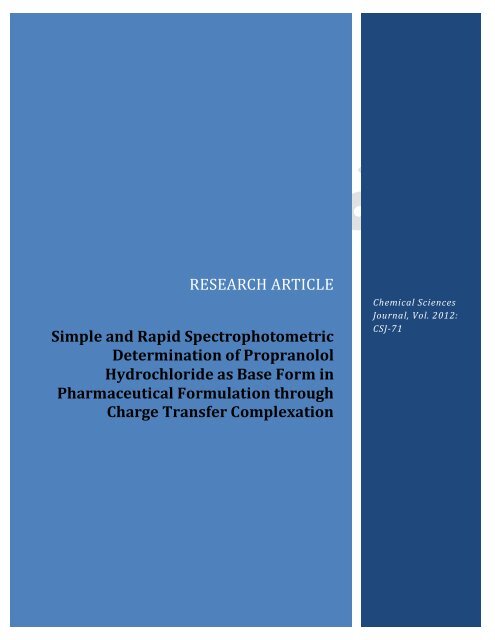
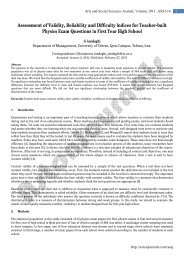
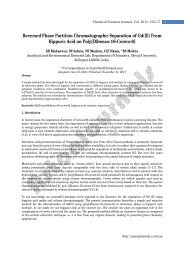
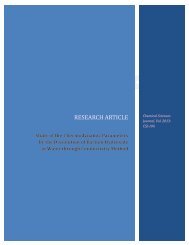
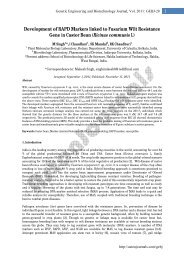

![[1,4]-benzodiazepine-2-one Derivatives as Potent - AstonJournals](https://img.yumpu.com/49117784/1/184x260/14-benzodiazepine-2-one-derivatives-as-potent-astonjournals.jpg?quality=85)
